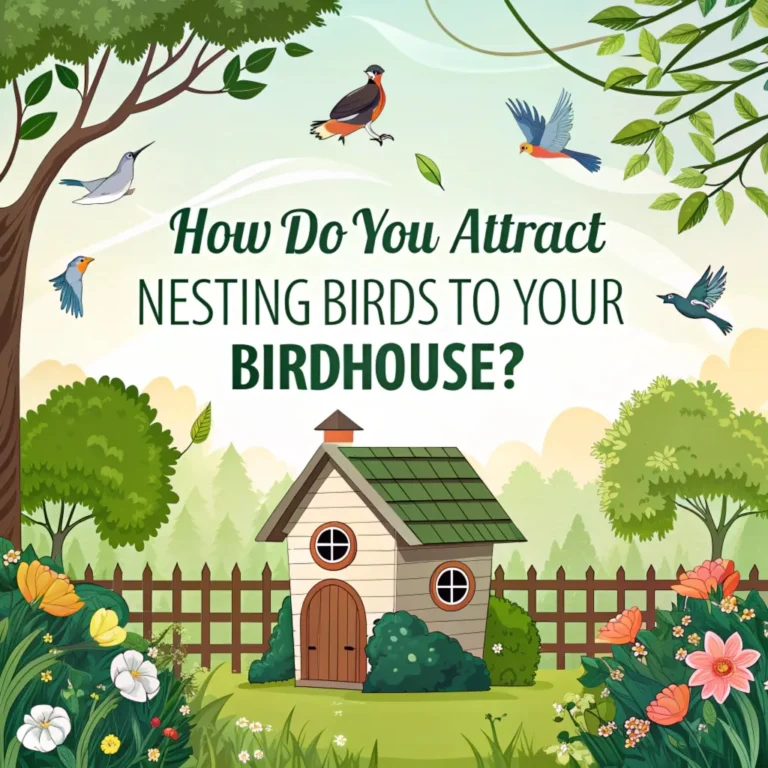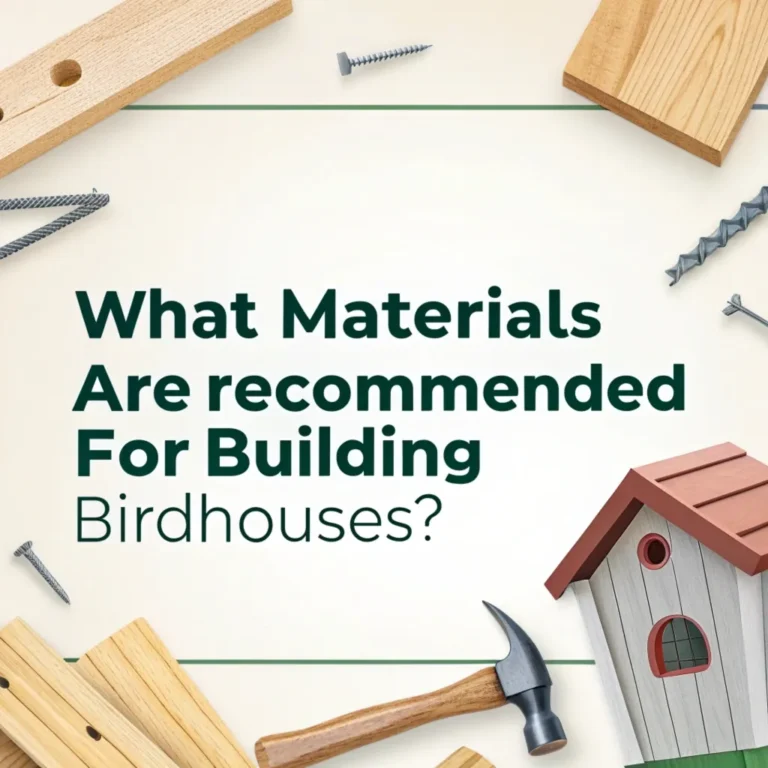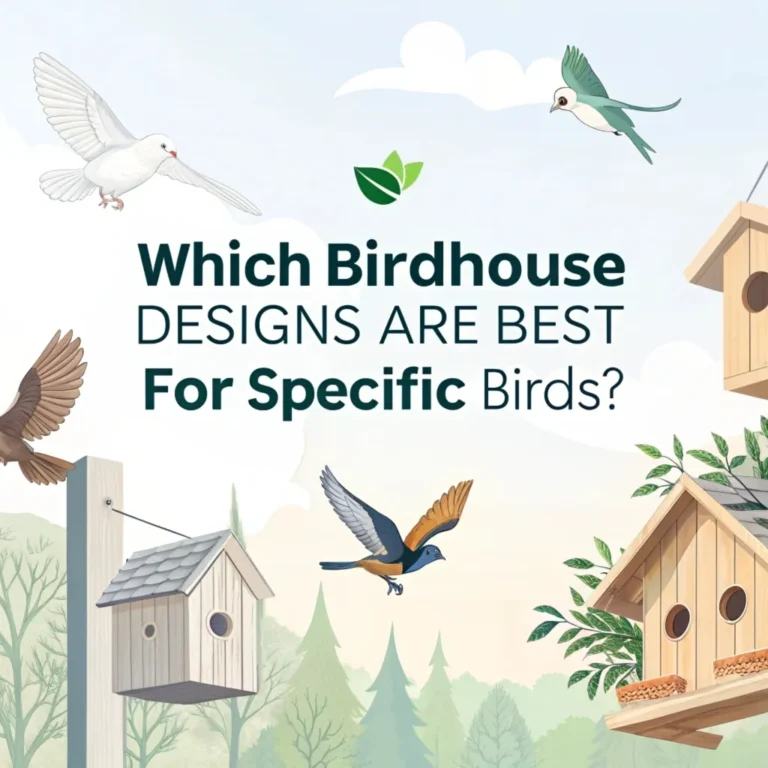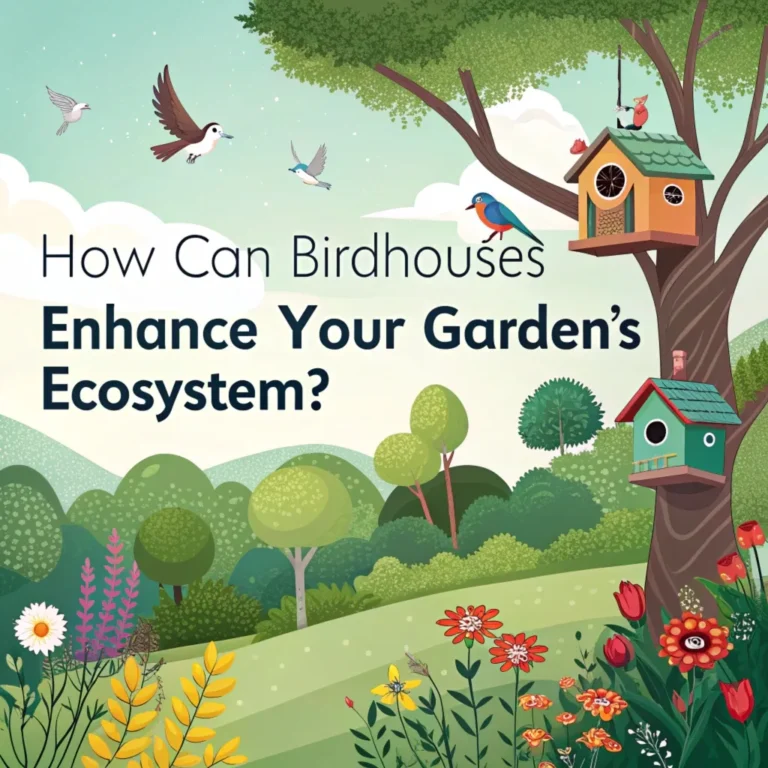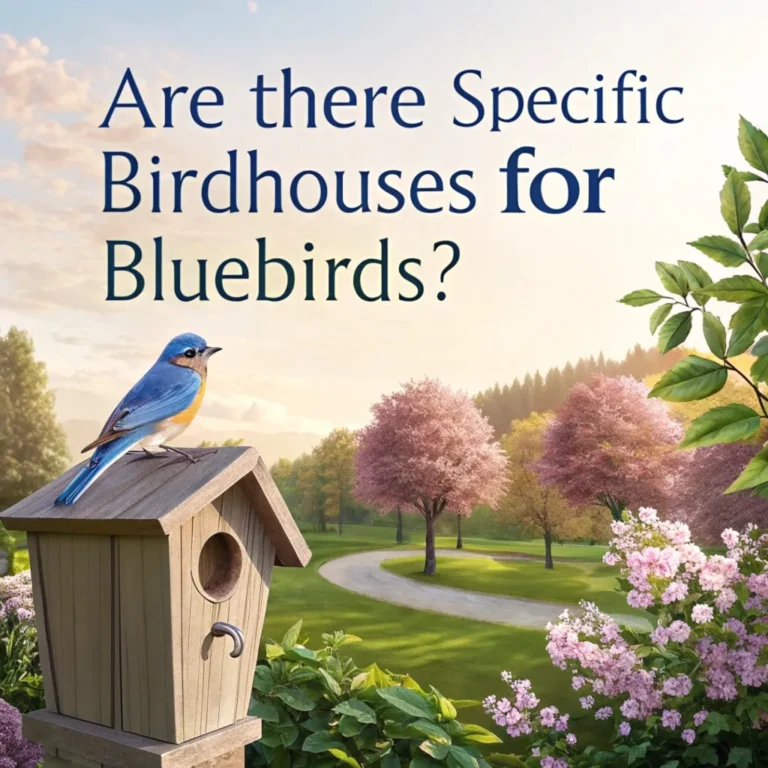How to Choose the Perfect Birdhouse for Your Backyard? A Comprehensive Guide
Selecting the right birdhouse for your backyard is a crucial step in attracting and supporting local bird populations.
A well-chosen birdhouse not only enhances the aesthetic appeal of your outdoor space but also provides essential shelter for nesting birds.
This guide will help you navigate the process of selecting the ideal birdhouse, considering factors such as design, size, placement, and maintenance to create a welcoming environment for your feathered friends.

Key Takeaways
- Design matters: Choose a simple, wooden birdhouse with a neutral color and no perch.
- Size is crucial: Match the birdhouse size to the species you want to attract.
- Entrance hole diameter is critical for species-specific attraction and predator protection.
- Proper placement depends on the bird species and your yard’s characteristics.
- Easy maintenance is essential for the health and safety of nesting birds.
- Weather resistance is important for year-round protection.
- Natural materials like wood are best for insulation and ventilation.
- Multiple birdhouses can attract different species to your yard.
- Local bird species should guide your birdhouse selection.
- Safety features such as predator guards and proper ventilation are vital.
The selection of a birdhouse is a thoughtful process that requires consideration of various factors to ensure the well-being of your avian visitors.
By understanding the specific needs of different bird species and the essential features of a quality birdhouse, you can create an inviting habitat that supports local bird populations.
This guide will provide you with the knowledge and insights necessary to make an informed decision when choosing a birdhouse for your backyard.
Understanding Birdhouse Basics
The foundation of choosing the perfect birdhouse lies in understanding the basic requirements of nesting birds. A good birdhouse simulates a natural cavity, providing protection, privacy, and comfort for its inhabitants.
Birdhouses play a crucial role in supporting bird populations, especially in urban and suburban areas where natural nesting sites may be scarce.
These artificial structures offer birds a safe place to lay eggs, raise their young, and seek shelter from harsh weather conditions.
By providing a suitable birdhouse, you’re essentially creating a miniature ecosystem that can support multiple generations of birds.
When considering the basics of birdhouse design, it’s important to think like a bird. In nature, birds seek out cavities that offer protection from predators, shelter from the elements, and a comfortable space to raise their young.
A well-designed birdhouse should mimic these natural conditions, providing a secure and cozy environment that meets the specific needs of different bird species.
Selecting the Right Material

Wood is the optimal material for birdhouses. Its porous nature allows for proper ventilation and moisture regulation, crucial for maintaining a comfortable environment for nestlings.
Avoid metal or plastic birdhouses, as these materials can lead to overheating.
The choice of wood for your birdhouse is an important consideration. Cedar, pine, and redwood are excellent options due to their natural resistance to decay and insect infestation.
These woods also provide good insulation, helping to regulate temperature inside the birdhouse. Avoid using pressure-treated wood, as it may contain chemicals harmful to birds.
When selecting wood for your birdhouse, consider its durability and weathering properties. Hardwoods like oak or maple can be used but may be more difficult to work with and heavier to mount.
Softwoods like cedar are lightweight, easy to work with, and naturally resistant to rot, making them an ideal choice for birdhouses. Whichever wood you choose, ensure it’s untreated and free from any toxic finishes or preservatives.
Design Considerations
Simple is Best
When it comes to birdhouse design, simplicity is key. Birds prefer functional structures over decorative ones. Avoid bright colors, intricate designs, or unnecessary embellishments that may deter birds or attract predators.
Size Matters
The size of the birdhouse should match the species you aim to attract. Smaller birds like wrens prefer compact spaces, while larger birds such as bluebirds require more room. Research the specific needs of your local bird species to determine the appropriate dimensions.
Entrance Hole Diameter
The entrance hole size is a critical factor in birdhouse selection. It should be large enough for the target species to enter but small enough to exclude larger predators or competing species. For most small to medium-sized birds, a hole diameter between 1 and 1.25 inches is suitable.
The design of your birdhouse plays a significant role in its attractiveness to birds and its effectiveness as a nesting site.
While it may be tempting to choose an ornate or colorful birdhouse, remember that birds are looking for a safe and functional home, not a decorative piece.
Natural wood tones and simple designs are more likely to attract birds and blend seamlessly into your backyard environment.
Consider the specific needs of the bird species you’re hoping to attract when designing or selecting a birdhouse. For example, some birds prefer houses with sloped roofs, while others need a certain depth from the entrance hole to the floor for nesting.
Researching the preferences of local bird species can help you choose or create a birdhouse that meets their specific requirements, increasing the likelihood of attracting nesting pairs to your yard.
Ensuring Proper Ventilation and Drainage

A well-designed birdhouse includes features for proper air circulation and water drainage. Look for birdhouses with:
- Ventilation holes near the top of the side walls
- Drainage holes in the bottom to prevent water accumulation
- A sloped roof extending over the front and sides to keep out rain
Proper ventilation and drainage are crucial for maintaining a healthy environment inside the birdhouse. Without adequate airflow, the interior can become stuffy and humid, potentially leading to the growth of mold or mildew that can harm nestlings.
Ventilation holes near the top of the side walls allow warm air to escape, while drainage holes in the bottom prevent water from pooling inside the house during rainy weather.
The roof design of a birdhouse is another important factor in ensuring proper drainage.
A sloped roof that extends slightly over the front and sides of the house helps to keep rain from entering through the entrance hole or seeping in through the walls.
This overhang also provides some shade, helping to regulate the temperature inside the birdhouse during hot summer days.
Facilitating Easy Maintenance
Choose a birdhouse with a hinged side or lifting roof for easy access to the interior. This feature allows for regular cleaning and nest removal between brooding seasons, essential for maintaining a healthy environment for birds.
Regular maintenance of your birdhouse is crucial for the health and safety of its inhabitants. A birdhouse that’s easy to clean will encourage you to perform this important task more frequently.
Look for designs that allow you to easily access the interior without disturbing the structure of the house. This might include a hinged side panel, a removable front, or a roof that can be lifted off.
The importance of cleaning a birdhouse cannot be overstated. After each nesting season, old nests should be removed to prevent the buildup of parasites and diseases.
A clean birdhouse is more likely to attract nesting pairs in the following season. When cleaning, use mild soap and water, avoiding harsh chemicals that could harm future bird inhabitants. Allow the birdhouse to dry completely before closing it up for the next season.
Placement Strategies
Height and Location
The ideal height and location for your birdhouse depend on the species you want to attract. Generally, birdhouses should be placed:
- 5 to 10 feet above the ground for most small to medium-sized birds
- Away from direct sunlight and prevailing winds
- In a location with some nearby cover, such as trees or shrubs
Multiple Birdhouses
Installing multiple birdhouses in your yard can attract a variety of species. Place houses for the same species out of sight of each other to reduce territorial conflicts.
The strategic placement of your birdhouse is as important as its design. Different bird species have varying preferences for nesting locations, so research the habits of the birds you hope to attract.
Some birds prefer open areas, while others feel more secure near tree trunks or shrubs. Consider the natural habitats of your target species and try to mimic these conditions in your yard.
When placing multiple birdhouses, consider the territorial nature of many bird species. Houses for the same species should be placed far enough apart to prevent territorial disputes.
However, some colonial nesters, like purple martins, prefer to nest in close proximity to others of their species. Understanding these behaviors will help you create a harmonious bird community in your backyard.
Adapting to Seasonal Changes
Choose a birdhouse that can withstand various weather conditions throughout the year. Look for features such as:
- Thick walls for insulation
- Waterproof seals around the entrance
- Natural wood preservatives like linseed oil for weather protection
Seasonal adaptations are crucial for ensuring your birdhouse remains a safe and comfortable shelter year-round. In colder climates, consider birdhouses with thicker walls to provide better insulation during winter months.
This extra protection can be vital for birds that use birdhouses as roosting spots during cold nights, even outside of the nesting season.
For areas with high rainfall, pay special attention to waterproofing features. A well-sealed roof and entrance hole can prevent water from seeping into the birdhouse, keeping the interior dry and comfortable.
Additionally, consider applying a natural, non-toxic wood preservative to the exterior of the birdhouse to protect it from weathering and extend its lifespan.
Attracting Specific Bird Species
Research the nesting preferences of birds common to your area. For example:
- Wrens prefer houses with a 4″ x 4″ or 4″ x 6″ base and a 1-1/8″ entrance hole
- Bluebirds need a slightly larger house with specific entrance hole sizes for each species
Understanding local bird species is key to successfully attracting them to your birdhouse. Different birds have evolved to prefer specific nesting conditions, and by catering to these preferences, you can increase the likelihood of attracting your desired species.
Research the types of birds native to your area and their specific nesting requirements, including house dimensions, entrance hole size, and preferred habitat.
Consider creating a diverse bird habitat in your yard to attract a variety of species. This might include offering different types of birdhouses, as well as providing food sources and water features.
Remember that some birds, like woodpeckers and nuthatches, prefer to excavate their own nesting cavities. For these species, consider offering nesting blocks made of soft wood that they can excavate themselves.
Safety Features
Incorporate safety features to protect nesting birds:
- Omit perches, which can aid predators in accessing the nest
- Consider adding predator guards around the entrance hole
- Ensure the birdhouse is securely mounted to prevent tipping or falling
The safety of nesting birds should be a top priority when selecting or designing a birdhouse. Predators such as cats, raccoons, and larger birds can pose a significant threat to eggs and nestlings.
Avoid adding perches to your birdhouse, as these can provide easy access for predators. Instead, birds can comfortably grip the edge of the entrance hole when entering and exiting.
Predator guards are an excellent addition to any birdhouse. These can be simple metal plates around the entrance hole that prevent predators from reaching inside or enlarging the hole.
For pole-mounted birdhouses, consider adding a baffle below the house to prevent climbing predators from reaching the nest.
Ensure that your birdhouse is securely mounted to prevent it from swaying in strong winds or falling, which could harm the nest occupants.
Matching Your Yard’s Aesthetic
While functionality is paramount, you can still choose a birdhouse that complements your yard’s style. Opt for natural wood tones or subtle earth colors that blend with the surrounding environment.
Integrating your birdhouse into your yard’s overall aesthetic can create a harmonious outdoor space that’s pleasing to both birds and humans.
While the needs of the birds should always come first, there are ways to ensure your birdhouse complements your landscaping.
Consider the architectural style of your home and the overall theme of your garden when selecting or designing your birdhouse.
Natural finishes are often the best choice for birdhouses, as they blend well with outdoor environments and are less likely to deter birds. If you do choose to paint your birdhouse, opt for subtle earth tones or muted colors that won’t stand out too much in the landscape.
Avoid using bright or metallic paints, as these can be unappealing to birds and may even attract unwanted attention from predators.
Maintaining Your Birdhouse
Regular maintenance is crucial for the longevity of your birdhouse and the health of its inhabitants. Clean the birdhouse annually, preferably in late fall or early spring before the nesting season begins.
Proper maintenance of your birdhouse is essential for ensuring its long-term use and the health of its inhabitants. Regular cleaning helps prevent the buildup of parasites, diseases, and old nesting material that can harm future broods.
Plan to clean your birdhouse at least once a year, ideally after the nesting season has ended and before new residents arrive in the spring.
When cleaning your birdhouse, wear gloves and a dust mask to protect yourself from any potential pathogens. Remove old nesting material and debris, and scrub the interior with a solution of one part bleach to nine parts water.
Rinse thoroughly and allow the birdhouse to dry completely before closing it up. This annual cleaning ritual not only maintains a healthy environment for birds but also gives you an opportunity to check for any damage or wear that may need to be addressed.
FAQs
What is the best material for a birdhouse?
Wood is the best material for birdhouses. It provides natural insulation and allows for proper ventilation and moisture regulation.
How often should I clean my birdhouse?
Clean your birdhouse at least once a year, ideally in late fall or early spring before the nesting season starts.
Can I paint my birdhouse?
It’s best to leave wooden birdhouses unpainted or use natural wood stains. If you choose to paint, use earth tones and avoid bright colors that may deter birds.
How high should I mount my birdhouse?
The ideal height varies by species, but generally, 5 to 10 feet above the ground is suitable for most small to medium-sized birds.
Do birdhouses need perches?
No, birdhouses do not need perches. In fact, perches can make it easier for predators to access the nest and should be avoided.
How can I protect my birdhouse from predators?
Use predator guards, ensure proper entrance hole size, and place the birdhouse in a location that’s difficult for predators to access.
Can I have multiple birdhouses in my yard?
Yes, multiple birdhouses can attract different species. Place houses for the same species out of sight of each other to reduce territorial conflicts.
What size should the entrance hole be?
The entrance hole size depends on the species you want to attract. For most small to medium-sized birds, a diameter between 1 and 1.25 inches is suitable.
How do I know if birds are using my birdhouse?
Look for signs of nesting material, hear chirping sounds from inside, or observe birds entering and exiting the house.
Should I provide nesting material for the birds?
It’s best to let birds gather their own nesting materials. You can provide natural fibers or small twigs nearby, but avoid putting them directly in the birdhouse.

Luna is the passionate founder and author of Birds and You, a website dedicated to sharing her love for birds with fellow enthusiasts. Through her engaging articles and guides, she aims to educate and inspire others to explore the fascinating world of birds. When she’s not writing, you can find Luna observing birds in their natural habitats or sharing beautiful bird photography on Pinterest. Join her on this journey to celebrate and protect our feathered friends!


